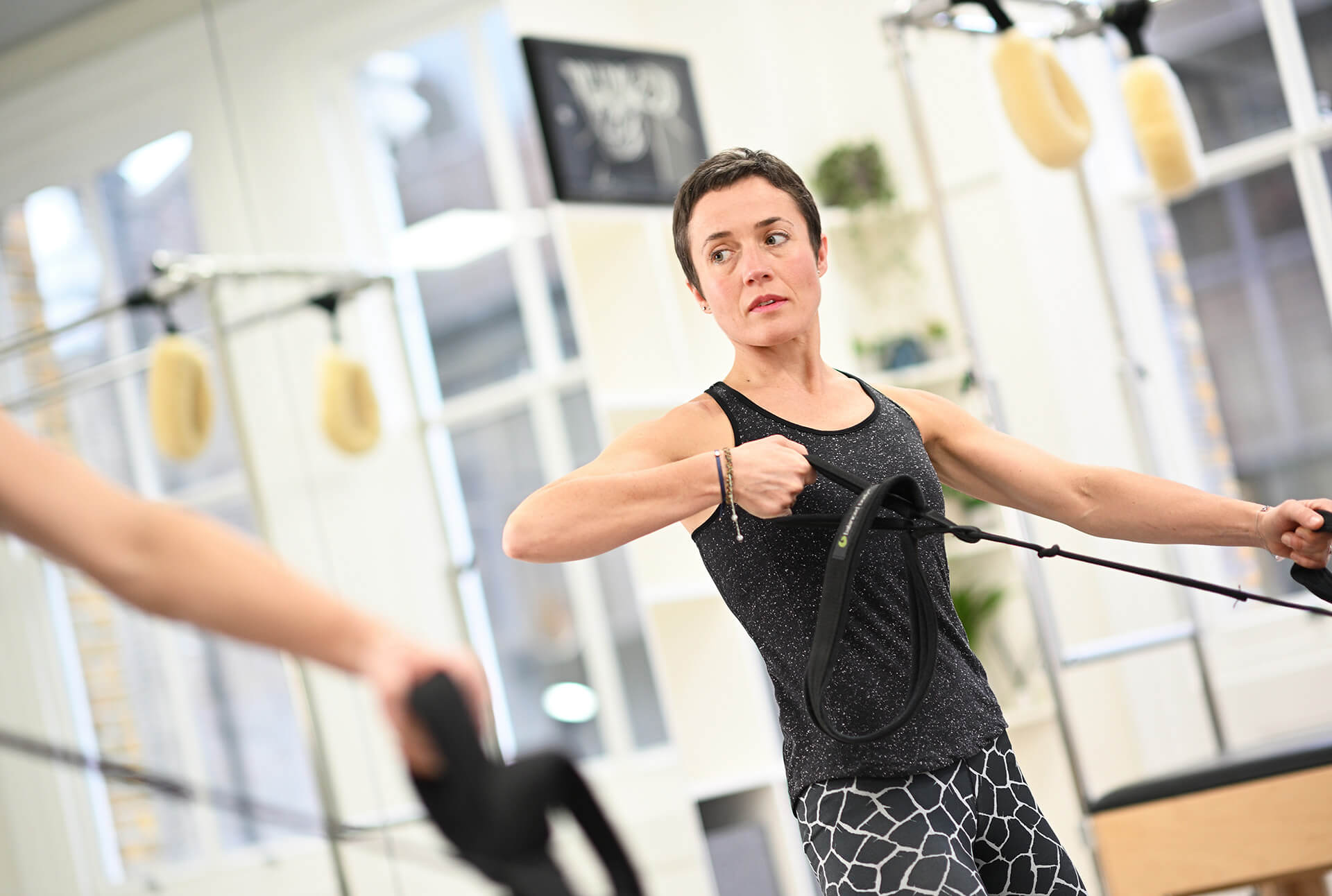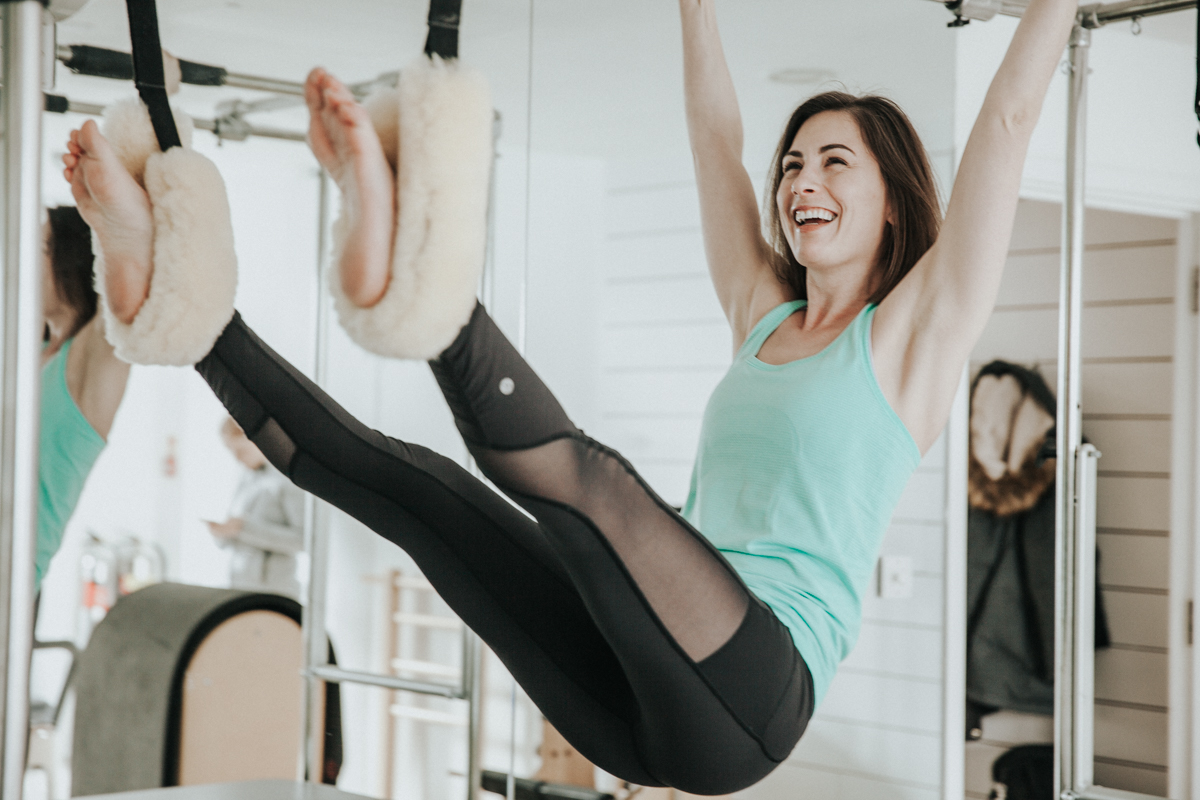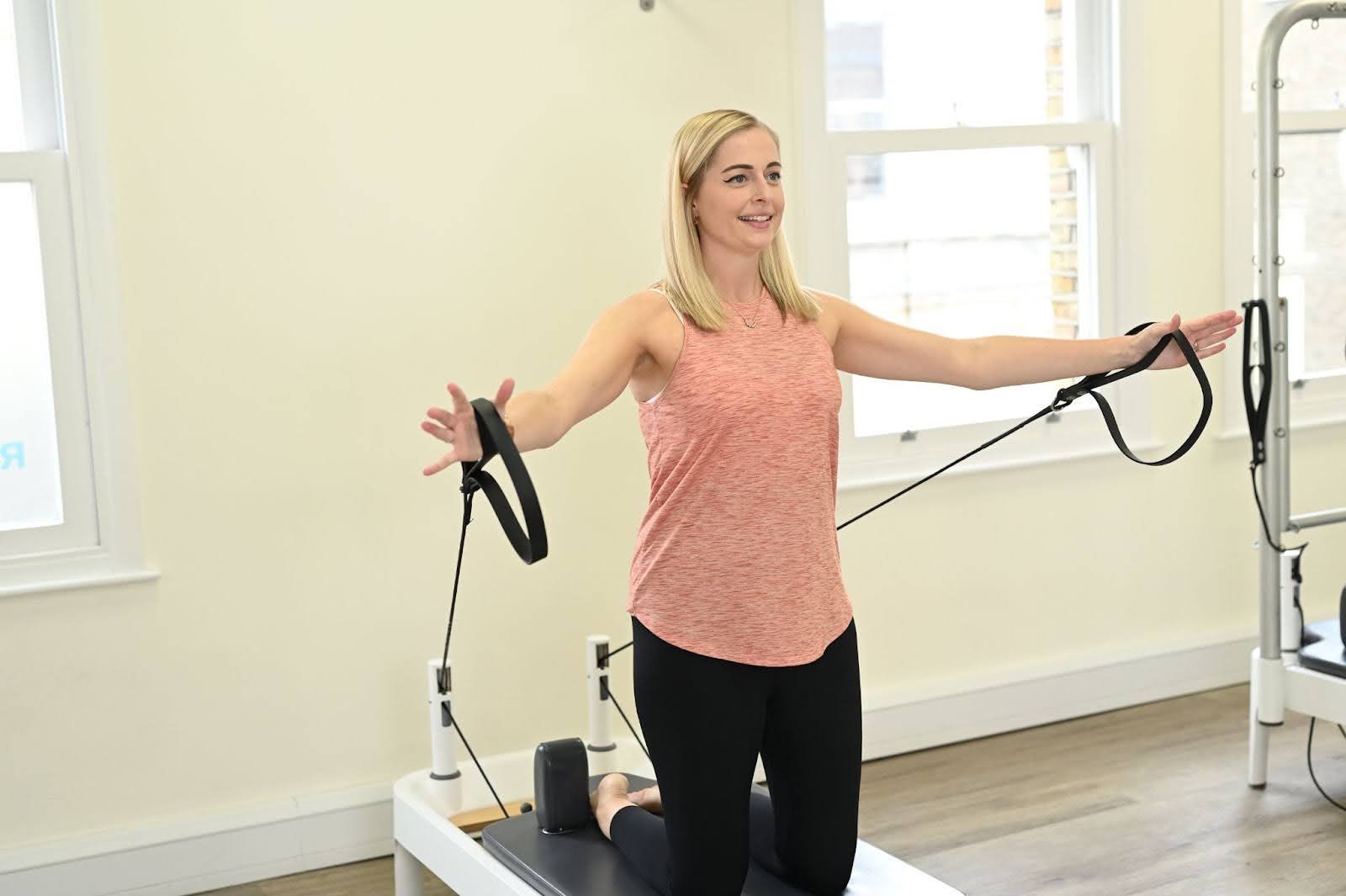Key Contributor: Susie Martin, Chartered Physiotherapist
Introduction
Reformer Pilates has become incredibly popular in recent years and for some feels like a real game changer in how they approach exercise.
Pilates also has gained something of a reputation for helping people change their bodies, with many on social media touting the transformational powers of reformer Pilates. But is it really so transformational? And just what sort of transformation might you expect from reformer Pilates?
Read on to find out more about what reformer Pilates is, what the benefits are, and what you can expect when you are regularly practicing reformer Pilates.
Key Takeaways
- Reformer Pilates is a great choice of low impact exercise for working on strength, stability and flexibility.
- Reformer Pilates is well recognised as a tool for improving your body, and especially for working on your core strength. You can begin to notice these changes within your body straight away, but real change occurs over a period of weeks to months.
- Reformer Pilates doesn’t just provide physical benefits, but can also contribute to improved mind-body connection and a sense of wellbeing.
What is Reformer Pilates?
We have a whole other page on Reformer Pilates but for those who are short on time, reformer Pilates is simply a select part of the wider Pilates repertoire which is done using a reformer machine. Reformer Pilates is actually not new – it has been part of the Pilates system all along.
The creator of Pilates, Joseph Pilates, patented the ‘Universal Reformer’ way back in 1926. In recent decades, reformer Pilates has exploded in popularity, partly due to the fact it can work well in a group exercise setting, and so has become accessible to more people.
What changes will I notice with Reformer Pilates?
As with many other types of exercise, the advantages of reformer Pilates are many, with both physical and mental benefits.
Physical changes
Improved core strength
Many of the exercises on a reformer engage your abdominal and back muscles. This is perhaps the most obvious and well recognised feature of reformer Pilates.
Working either through working against the resistance of the springs or the carriage helps engage the whole body, including your core. Not only that but your deep stabilising muscles are challenged by the reduced stability of moving parts on the reformer.
The supine (on your back) lying position on the reformer, whilst working arms and legs, is particularly good for working your abdominals, because of your position relative to gravity, but is more supported than similar exercises on the floor, because of the reformer straps. This means you can perform exercises with better technique, not losing energy to ineffective movement.
Increased Flexibility & Mobility
Many of the Pilates exercises aim to help you develop greater mobility through your spinal joints and ribcage, for example, the Mermaid stretch, or the Swan. These exercises can help you feel more mobile through your body and reduce feelings of stiffness.
Well taught Pilates will also encourage you to use the full range of your mobility but in a supported way that doesn’t strain you. This helps you to develop better tolerance to positions of stretch. Dynamic movements on the reformer can help you to improve joint range throughout the body.
Longer, Leaner Muscles
There is a popular belief that Pilates helps you to develop long lean muscles without increasing muscle bulk, however, there is no specific research evidence to say that this is true.
It is true that Pilates is a form of lower load strength training which can help to stimulate muscle activity and enhances the connection between brain and muscles. If you are new to exercise or new to Reformer Pilates you may notice that you feel stronger or that you can see some new muscle definition.
Pilates sessions tend to work with low sets and repetitions, and focus more on movement technique. To achieve an increase in muscle size, multiple sets and repetitions with moderate to high loads are required, so you are unlikely to increase muscle size with Pilates.
Muscle definition is not only dependent on regular resistance training but depends on other factors, such as – your body fat content, your genetics and your diet. As for long lean limbs, this is also likely somewhat dependent on your genetics. Pilates does work your muscles in their lengthened positions, which may aid flexibility and result in less compact muscles but it is unlikely to have a significant transformative effect on your natural stature.
Better Posture & Alignment
Well taught Pilates has a focus on precision movement, postural alignment and technique. It should also prompt you in a way that increases your own awareness of these things. Improved awareness of your body position and movement can go a long way to helping improve posture.
However, continued awareness and practice outside of Pilates sessions is needed to maintain such changes, and you still need to be aware of your posture when you are no
Whilst improved posture can be more aesthetically pleasing, there is no perfect posture, and it is important to recognise that ‘your best posture is your next posture’, meaning we should change positions and move regularly. Good posture is not about holding rigid positions.
With increasing sedentary lifestyles, we tend to adopt more rounded positions (flexion) and neglect the strength of the upper back muscles which help to improve posture. Many Pilates exercises help the spine to move into the opposite direction (extension) and work on gentle strengthening of the upper back muscles which support these positions.
Other powerful benefits of reformer Pilates
Body Awareness & Mind-Muscle Connection
One of the original principles of Pilates was concentration and a good quality Pilates teacher will encourage you to pay attention to your body as you move. They can also suggest small tweaks to improve your movement.
By focussing on your bodily sensations, you will gain more awareness of your movement quality and effectiveness. This can help you to recognise small adjustments that you can make to get more out of any exercise that you do, and make every repetition count.
Confidence & Energy Boost
Reformer Pilates can help you to build a stronger, flexible, injury free body. This in turn can lead to better energy levels and to mproved sense of vitality and well being.
It can also lead to improved self-esteem through progressions of strength and ability.
Injury Prevention and Recovery
Reformer Pilates helps you to develop more efficient movement patterns, and move in ways that reduce strain and compensatory movement strategies. This is because of the emphasis on controlled movement and stability. This ultimately makes movement more efficient and effective and reduces the likelihood of poor biomechanics contributing to injury.
Reformer Pilates is also really versatile, so it can help you to continue exercise whilst you recover from injury. For example, if you have sustained an injury to your leg, which means that you have more difficulty weight bearing, you can exercise by lying or sitting on the reformer and still work all the muscles in your body, as well as gently working the injured area.
You can work on joint range, gentle muscle strengthening and joint stability, to help rehabilitate the injured area.
How long before you notice changes?
Some people will feel different even after one reformer Pilates session as they start to use muscles that they don’t normally work.
Improving the connectin between your mind and your muscles is an ongoing process but generally occurs in the first 2 – 6 weeks of exercise.
After 8 – 12 weeks of resistance exercise, your muscle fibres start to adapt in response to the new load, either by improving their endurance or, with sufficient load, ability to generate force.
Improvements will be best with regular and consistent practice. For improvements in strength, 1 session per week is the minimum you should aim for. Practicing 2 – 3 times per week over several months will improve your strength more noticeably, and rest days are important, as this is when strength adaptations occur.
Progressive increase in load is necessary as your body adapts to the demands of the exercise, so make sure that your challenge in either resistance or stability is increasing every few weeks.
Who will benefit the most?
We believe that everyone can gain improvements in their strength and mobility through reformer Pilates practice. Joseph Pilates himself believed that ‘Pilates is for everybody’.
However, the following groups may benefit in particular ways….
Office workers
Office workers will benefit from reformer Pilates through its focus on spinal mobility exercises in multiple directions, to combat the lack of movement in sitting postures.
They will also benefit from exercises that target the back muscles and abdominal muscles that are less active when sitting.
New mums
New mums can benefit from reformer Pilates through its supportive way of building abdominal strength. They can benefit from working on upper body strength to help them with carrying the weight of the baby as he or she grows bigger.
New mums can also benefit from working on upper back mobility – it is common to experience lack of mobility and stiffness through the upper back with the effects of pregnancy and subsequent breastfeeding postures, or holding baby.
Older adults
Older adults can benefit from the lower intensity, low impact strength training that reformer Pilates can provide.
The resistance settings on the reformer can be set up to provide a much more comfortable load to work with compared to, say, gym equipment.
The loads can be progressed, and may be enough to stimulate more strength and muscle development, in those who are slighter or frailer.
Athletes/dancers
Athletes will benefit from reformer Pilates since it provides a very different type of trainer compared to the explosive type of activity that they may be engaged in during their sports.
The precision and controlled movements of Pilates may prove more challenging than they expect, and can help to work on the joint stability that underpins effective and efficient movement.
Dancers may also benefit from the strength and stability gained through Pilates, with the added benefit of being able to work into their full range of movement, as the Pilates repertoire contains many exercises that require and encourage greater flexibility.
Those recovering from injury
Reformer Pilates is perfectly suited to those who are recovering from injury since it allows you to work out your whole body, whether it is to maintain strength and mobility away from the site of injury or whether it is to gently rehabilitate the injury.
For example the set up of the Reformer enables you to work on gentle strength and range of movement without loading the weight of the body on the hip, knee and ankle. This is perfect for those who might be recovering from surgery for any of these joints.
FAQs
Can reformer Pilates help with weight loss?
Reformer PIlates alone is unlikely to help you lose weight as it does not burn sufficient calories, and is unlikely to build sufficient extra muscle tissue to alter your metabolism. It can be used as part of a well rounded programme which includes diet and exercise.
Cardiovascular exercise and moderate to heavy load strength training will both promote weight loss and an increase in metabolism.
Will I get bulky if I do Reformer Pilates?
It is unlikely that you will get bulky through doing Reformer Pilates. Generally speaking, Reformer Pilates doesn’t operate with the kind of heavier loads or volume of repetitions that is needed to create an increase in muscle size (known as muscle hypertrophy). Muscle hypertrophy is mostly generated through using medium to heavy loads with multiple sets of repetitions, working a muscle through its entire range.
Reformer Pilates generally uses more moderate loads, and has lots of static holds, and slow controlled movements. Many of the exercises are also focused on full body mobility, rather than strength, and we are often working muscles in their more lengthened range, which encourages muscle length and flexibility.
Is Reformer Pilates enough as my only form of exercise?
Reformer Pilates will give you many benefits in terms of full body strength and mobility, and is particularly good for the strength of your torso. However, Reformer Pilates does not contain all the elements of exercise that are recommended for health and fitness.
The American College of Sports Medicine (ACSM) recommends that adults do aerobic exercise most days of the week and exercise that increases muscle strength endurance on a minimum of two days per week.
Aerobic (also known as cardiovascular) exercise, is important for prevention of so called ‘lifestyle’ diseases such as hypertension, diabetes, obesity and heart disease.
Strength training exercise is important because maintaining our strength helps us keep being able to do the things we want to do. Muscle is also important for general health as muscle tissue burns more energy than fatty tissue, and it helps us to metabolise sugar effectively.
Every decade after 40 years old, we are losing about 10% of our muscle mass, so it is important to maximise our muscle mass to reduce the impact of this loss.
Loss of muscle as we age contributes to lack of independence, as we need other people to help us with lifting and carrying things. It can make it harder to do simple things such as getting out of a chair, climbing stairs, and carrying bags. It can also put us at risk of falls as we lose our ability to maintain balance.
Reformer Pilates can be considered to be a form of resistance training, and therefore can help increase muscle strength and endurance, However, it may not create enough resistance for building muscle size, or speed, which helps develop explosive power. Some people will find they need to do additional strength training such as working with weights or resistance bands.
Most Reformer Pilates classes cannot be classed as aerobic exercise because it does not increase your heart rate enough. However, some reformer classes have been adapted to include faster movements and weights, and these may be aerobic for some, depending on their fitness level. Generally, though, fast walking, cycling, swimming, running or circuit style classes are more appropriate for meeting aerobic exercise recommendations.
How is this different from regular gym workouts?
Reformer Pilates is different from regular gym workouts in a few different ways. Firstly, the reformer is the key piece of equipment that is always used, whereas in a gym you will use multiple different pieces of equipment.
Depending on what you do in your regular gym workout, the structure of a Pilates session may be quite different. A Pilates class may have more different exercises in it, but you tend to flow from one exercise to the next, whereas if you are doing a strength training programme you may be doing multiple sets of one exercise, and you may take more rests.
If you are doing more circuit style exercise, you may be resting less between exercises, but still performing multiple sets of an exercise.
If you are doing cardiovascular exercise in the gym, such as cycling, treadmill or circuits, you will likely be getting your heart rate up, and feel more hot, sweaty and breathless. In Pilates, you are less likely to increase your heart and breathing rate, and less likely to sweat. But you will feel like you are working hard!
Doing Pilates can feel more fluid than gym workouts and there is more of a focus on flexibility and mobility as part of the exercises. Many Pilates exercises have a flow to them, and sometimes movements that are a bit like dance choreography to challenge your co-ordination. This can make it much more varied, engaging and fun, compared to grinding out sets and reps at a gym.
A good reformer Pilates class should also include attention to how you are moving, and a focus on good form. This helps you get more out of each exercise. Most gym classes have more a focus on exertion over quality of movement.
Conclusion
Reformer Pilates is a fantastic way to exercise and as a result has many fans. It is Pilates is a great way of increasing strength, mobility and flexibility.
Many devotees swear by reformer Pilates for changing their body. Reformer Pilates may help improve your body aesthetic as part of a wider strategy involving a healthy diet and a variety of cardiovascular and strength exercise.
However, for us at Complete Pilates, reformer Pilates isn’t about how you look. Reformer Pilates is about moving well, getting strong and feeling good, whatever your age, size and condition. It’s the ultimate in looking after your mind and body.
Feeling inspired?
If you want to experience the Complete difference and discover the benefits of one-to-one Pilates, book a session at one of our London studios or online today.
Our physiotherapist-led Pilates studios in Chelsea, our Angel Pilates studio and our Pilates studio in City, offer a highly tailored approach to your Pilates training, whether your goal is to manage a health condition, rehabilitate from an injury or to improve your strength and fitness.
Get in touch with us via email or contact us on 0203 764 5668 for further information.
Come and try Pilates in the City of London, or any of our studios (see our Kensington Pilates studio or Islington Pilates studio). For more information, please get in touch online or contact us on 020 4572 0243.
Education is key:
These blogs are designed to give information to everyone, however, it is important to remember that everyone is different! If you have not seen one of our therapists and have any questions about injuries, what you have read or whether this may be useful to you, please just ask. We are more than happy to help anyone and point you in the right direction. Our biggest belief is that education is key. The more you understand about your injury, illness and movement, the more you are likely to improve.






